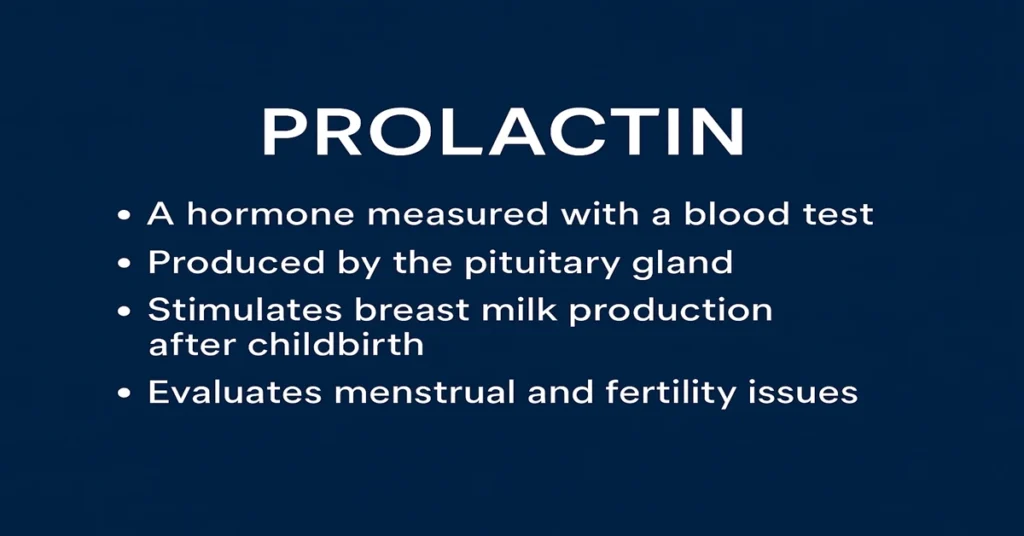Introduction
The Prolactin test is a blood test that measures the amount of prolactin hormone in your bloodstream.
Prolactin is mainly known for its role in stimulating breast milk production after childbirth, but it also affects fertility, menstrual cycles, and sexual health in both women and men.
Doctors usually recommend this test to check for menstrual irregularities, infertility, unexpected milk discharge (galactorrhea), or pituitary gland disorders.
What is Prolactin?
Prolactin is a hormone produced by the pituitary gland, located at the base of the brain.
While it is most active during and after pregnancy, prolactin also plays important roles in both female and male reproductive systems.
The prolactin test helps identify whether your body is producing too much or too little of this hormone. Abnormal prolactin levels can signal issues with the pituitary gland, thyroid, or reproductive organs.
Where is Prolactin Produced in the Body?
- Prolactin is secreted by the anterior pituitary gland.
- Its release is primarily inhibited by dopamine, a chemical messenger from the brain that prevents overproduction.
- During pregnancy and after childbirth, prolactin levels rise naturally to promote milk production.
This hormone’s production is a part of the hypothalamic-pituitary axis, which carefully controls reproductive and stress-related hormones.
Functions and Importance of Prolactin
In Females:
- Stimulates breast development during pregnancy
- Promotes milk production after childbirth (lactation)
- Regulates menstrual cycle and affects ovulation
- Helps maintain normal fertility balance by influencing estrogen levels
In Males:
- Regulates testosterone production indirectly through effects on other hormones
- Plays a role in sexual satisfaction, mood, and energy levels
- May influence immune response and metabolic processes
In both genders, prolactin helps the body adapt to stress and supports immune function and overall hormonal balance.
Causes of Low Prolactin Levels
Low prolactin levels are uncommon but can occur due to problems with the pituitary gland or certain medications.
Common Causes:
- Pituitary gland underactivity (hypopituitarism)
- Use of dopamine agonists (e.g., bromocriptine, cabergoline)
- Head injury or brain tumor affecting the pituitary
- Severe postpartum bleeding (Sheehan’s syndrome)
Symptoms of Low Prolactin Levels
In Females:
- Difficulty producing breast milk after childbirth
- Possible fertility problems (rare)
In Males:
- Usually no clear symptoms
- May occasionally cause decreased sexual desire or mild mood changes
Low prolactin is rarely a major concern unless associated with pituitary failure or other hormonal deficiencies.
Causes of High Prolactin Levels
High prolactin levels (a condition called hyperprolactinemia) are much more common. They can occur due to physiological, medical, or pathological reasons.
Common Causes:
- Pituitary tumors (prolactinomas) – most frequent cause
- Hypothyroidism (underactive thyroid gland)
- Chronic kidney or liver disease
- Pregnancy and breastfeeding (natural elevation)
- Severe emotional or physical stress
- Intense exercise
Medications that Increase Prolactin:
- Antipsychotics: Risperidone, Haloperidol
- Antidepressants: SSRIs, tricyclics
- Anti-nausea drugs: Metoclopramide
- Blood pressure drugs: Methyldopa
- Estrogen-based birth control pills
Symptoms of High Prolactin Levels
In Females:
- Irregular or missed menstrual periods
- Infertility due to lack of ovulation
- Galactorrhea (milk secretion without pregnancy)
- Hot flashes or vaginal dryness
- Breast tenderness
In Males:
- Low sex drive (decreased libido)
- Erectile dysfunction
- Infertility (low sperm count)
- Enlarged breasts (gynecomastia)
- Fatigue or low testosterone levels
If a prolactinoma is large, it may also cause headaches or vision problems due to pressure on nearby brain structures.
Reference (Normal) Ranges
(Note: Normal ranges may slightly vary between laboratories.)
- Non-pregnant females: 4.8 – 23.3 ng/mL
- Pregnant females: Up to 80 – 400 ng/mL (varies by trimester)
- Males: 4.0 – 15.2 ng/mL
- Children: Usually less than 10 ng/mL
- High Prolactin → May indicate pituitary tumor or thyroid disorder
- Low Prolactin → May indicate pituitary insufficiency
Sample Type
- Sample Type: Serum (blood sample)
- Tube Used: Red Top (Plain) or SST (Serum Separator Tube)
- Fasting Requirement: Usually not needed, but morning samples are preferred for accuracy.
Test Preparation
- Avoid stress and intense exercise 24 hours before the test.
- Avoid sexual activity or nipple stimulation for at least 12–24 hours before testing, as they can temporarily raise prolactin levels.
- Inform your doctor about medications like antipsychotics or antidepressants.
Blood is drawn from a vein in your arm, and results are typically available within a day.
When to Consult a Doctor
Consult your doctor if you notice any of the following:
- Irregular or absent periods
- Unexplained milk discharge (galactorrhea)
- Infertility or low libido
- Persistent headaches or vision changes
- Unusual breast swelling in men
Your doctor may order additional tests like TSH, MRI of the pituitary, or sex hormone levels to identify the cause.
Important Word Explanations
- Prolactin: Hormone responsible for milk production and reproductive function.
- Pituitary Gland: Gland at the base of the brain that controls hormone release.
- Dopamine: Brain chemical that inhibits prolactin secretion.
- Prolactinoma: Pituitary tumor producing excess prolactin.
- Galactorrhea: Unusual milk discharge unrelated to pregnancy or breastfeeding.
- Hypopituitarism: Underactive pituitary gland causing hormone deficiencies.
~END~

